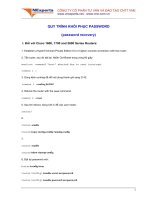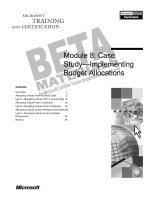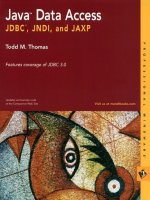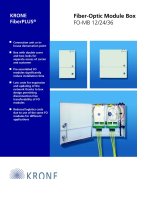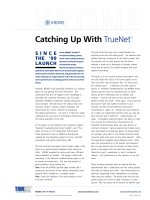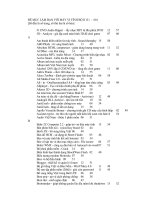Tài liệu Pursuing Wireless Excellence at Cedars-Sinai Medical Center pptx
Bạn đang xem bản rút gọn của tài liệu. Xem và tải ngay bản đầy đủ của tài liệu tại đây (252.31 KB, 3 trang )
CASE STUDY
Pursuing Wireless Excellence
at Cedars-Sinai Medical Center
CHALLENGE
Founded in 1902, Cedars-Sinai Medical Center is consistently ranked
as one of the top hospitals in the United States. Housed in seven
buildings in west Los Angeles, including three, 16-story towers, Cedars-
Sinai has more than 2,000 attending physicians and more than 8000
staff members from all walks of life (including research, teaching and
community service), all involved in the care of patients. Featuring a
Level I Trauma Center, several critical care facilities, operating rooms,
laboratories, a pharmacy, 950 patient rooms, and a cafeteria, Cedars-
Sinai is a premier medical education center, with some 60 graduate
medical education programs underway.
Throughout its million square-foot campus, Cedars-Sinai relies heavily
on fast and reliable communications. From the maintenance and
housekeeping staff to doctors and nurses in patient care units, everyone
employed in the campus must be constantly available. Prior to the year
2000, Cedars-Sinai relied on a combination of overhead paging, beepers
and two-way radios to connect with its physicians and staff, as was
the case with most hospitals at the time. But in its continuing effort
to provide the best care, Cedars-Sinai was an early adopter of wireless
infrastructure as a means of speeding communications.
In 2000, Cedars-Sinai’s IT department deployed the Ericsson Digital
Wireless Office Service (DWOS) service offered by AT&T wireless. DWOS
offered a vision of immediate connectivity for all Cedars-Sinai personnel.
“Our staff did a study in 2003 to see how cellular phones could improve
our response time, and we found that having cellular communications
saved about 30 minutes,” says David Dean, telecommunications system
CASE STUDY
engineer at Cedars-Sinai. “With the pagers,
sometimes you had to leave a message and
wait for a call-back just to have a 30-second
conversation. The DWOS system gave us
instant communications and greatly
increased peoples’ efficiency.”
Based on pico cells (individual, ceiling-mounted
cellular radios), the DWOS system improved
cellular coverage in some areas of the building
and offered call mobility, so that a person’s desk
and cell phones rang simultaneously whenever
he or she got a call. On the other hand, the
DWOS system was limited in some ways. First, it
operated on a proprietary, internal network, so
each cellular phone user had to be individually
authorized for use. In addition, the original system
had a capacity of only 600 users, and adding
more users would have required a complete
redesign. Finally, the network used older TDMA
technology, which was rapidly being supplanted
by other wireless technologies such as GSM,
CDMA, and iDEN.
As a result, Cedars-Sinai only offered AT&T
cellular phones to employees, nurses, and doctors
in the emergency, pathology, facilities, and some
intensive care groups because their relatively
mobile work styles made wireless availability
most critical.
SOMETHING OLD, SOMETHING NEW
In 2004, the Cedars-Sinai IT staff found out that
the DWOS product would be discontinued. As
a result, the IT staff immediately began looking
for a replacement system. This time, the medical
center’s early experience led to an expanded set
of requirements.
“We wanted to have complete cellular coverage
for anyone throughout the facility, not just in
certain areas, and we didn’t want to have to
worry about cellular traffic interfering with
medical telemetry equipment,” says Dean. “We
also wanted modern technology that gave our
users a wide choice of phones and service plans.”
After soliciting bids from all cellular carriers in the
Los Angeles area, Cedars-Sinai’s IT staff settled on
proposals from Cingular and Sprint Nextel. Both
solutions specified InterReach
®
Unison in-building
wireless systems.
“It was an in-building system with distributed
antennas that reminded us of the DWOS system,
so its functionality was easily explained,” says
Milo Chavez, senior project engineer. Other
carriers had proposed building macro base
stations near the campus and beaming them
at the hospital facility, but that approach raised
interference and coverage concerns. The Unison
system also distributed the same high signal
strength at each antenna, so phones could
operate on lower power because they always
get a good signal. “Those two things did a lot to
eliminate our concerns,” says Chavez.
Ultimately, the IT staff selected the offers from
both Cingluar and Sprint Nextel to give it the
widest possible selection of phones and services.
With their push-to-talk feature and rugged cases,
the Sprint Nextel phones were the best solution
for the emergency and nursing personnel, while
Cingular’s broader range of handsets (including
PDAs and smart phones) were better suited for
physicians and others who wanted voice calling
as well as synchronized e-mail, calendaring, and
other EDGE-based data services.
In addition, the Unison system offered far more
coverage and scalability to meet the facility’s
needs: expanding the system to support more
users and coverage is a simple matter of adding
new hubs and antennas. And rather than forcing
IT staff to give users permission to be on the
network, the system was caller-agnostic, providing
immediate service to anyone with a Cingular or
Sprint Nextel phone.
Finally, the new Unison system preserved the
call mobility feature thanks to deployment of an
Ascendant Mobility Server that fully integrates
with the medical center’s PBX.
Deployment took four months, beginning in
November 2005: the Cingular system was up
and running by December 31, 2005, and the
Sprint Nextel system went on-line in February
2006. The cellular service signals are provided by
on-site base stations installed by Cingular and
Sprint Nextel in the medical center’s telephone
room. From there, Unison Main Hubs distribute
the signal via fiber to Expansion Hubs located
in various buildings or on specific floors of the
high-rise buildings. The Expansion Hubs connect
via Cat-5 cable to Remote Access Units (RAUs)
and antennas. Thanks to this “active” electronic
CASE STUDY
Website: www.adc.com
From North America, Call Toll Free: 1-800-366-3891 • Outside of North America: +1-952-938-8080
Fax: +1-952-917-3237 • For a listing of ADC’s global sales office locations, please refer to our website.
ADC Telecommunications, Inc., P.O. Box 1101, Minneapolis, Minnesota USA 55440-1101
Specifications published here are current as of the date of publication of this document. Because we are continuously
improving our products, ADC reserves the right to change specifications without prior notice. At any time, you may
verify product specifications by contacting our headquarters office in Minneapolis. ADC Telecommunications, Inc.
views its patent portfolio as an important corporate asset and vigorously enforces its patents. Products or features
contained herein may be covered by one or more U.S. or foreign patents. An Equal Opportunity Employer
105916AE 2/08 Original © 2008 ADC Telecommunications, Inc. All Rights Reserved
design, the system offers end-to-end configuration, monitoring, and management for rapid responses to
any component failure.
In all, the Unison system at Cedars-Sinai includes 9 Main Hubs, 32 Expansion Hubs, and 206 antennas
covering all areas of the facility. The flush-mount antennas blend in with the ceilings, and the rest of the
equipment is completely hidden from view. Installers saved money and time by using existing cable risers
and raceways, and by linking buildings with existing fiber.
New Services, New Users
Since the system has been deployed, Cedars-Sinai has begun a campus-wide initiative to use cell phone
communications for as many users as possible. Soon after the system went live, there were 800 users.
There are 1300 users as of this writing (March, 2006), and new requests come in every week.
“Because it’s a more modern system with better phones and services, there are more groups within the
campus jumping on the bandwagon,” says JoAnne White, telecommunications health system manager.
Another benefit is that Cedars-Sinai visitors who are subscribers on Cingular or Sprint Nextel networks
can also get better coverage via the system. Since the Unison system is user-agnostic, visitors to the
campus now have great cellular coverage as well, although the hospital still restricts public cell phone
use to the lobby, cafeteria, waiting rooms, and some other areas.
Finally, Unison’s complete call monitoring ensures that Cingular or Sprint Nextel knows immediately if
an antenna is down. In that event, the carrier or the deployment staff can quickly make a replacement.
“We had an antenna down once got it fixed right away,” says Chavez.
Seeing the Future
Dean sees the new Unison system as eventually supporting most of the employees and staff at Cedars-
Sinai, and he’s also excited about the new data capabilities that have become available. He has begun
reading up on mobile applications, and plans to look at some ideas that may further improve hospital
operations in the future. “With TDMA, text messaging was a big deal,” he says, “so it will be interesting
to see what we can do now.” Eventually, Cingular will upgrade its data service to HSDPA, which delivers
over 1 megabit per second.
But the most important thing for this highly-regarded medical center is that it now has a comprehensive,
reliable, and high-performance wireless voice and data communications system through which to
continue its pursuit of health care excellence. And as future cellular services and higher data throughput
become available, they can be delivered on the Unison system without requiring any system upgrade. For
Cedars-Sinai, improvements in communications and medical care will now go hand in hand.
